To view previous releases, select one from the dropdown box:
Currently displaying information released on: December, 2025
US CONSUMER PRICE INDEX, NOVEMBER 2025
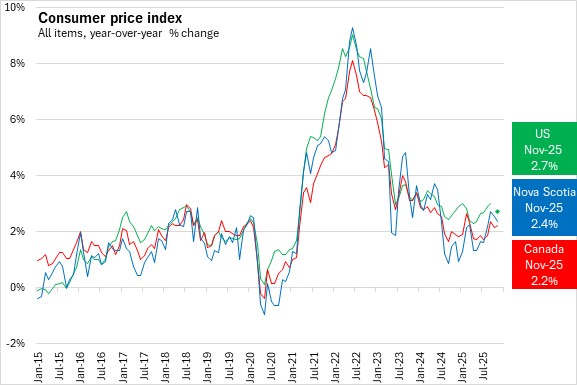
The United States Consumer Price Index (not seasonally adjusted) for All Urban Consumers increased 2.7% year-over-year in November 2025, down from the 3.0% year-over-year pace in September 2025. October inflation was not published due to the US government shut down.
Compared to November 2024, the US energy price index was up 4.2%. The gasoline price index was up 0.9%. The food index rose 2.6% and the shelter index was up 3.0% year-over-year.
The US CPI excluding food and energy rose 2.6% compared to November 2024.
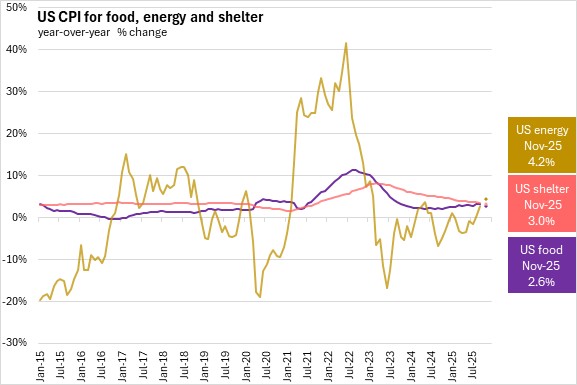
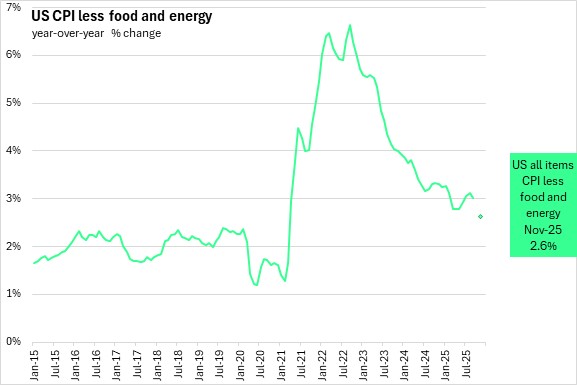
Sources: Statistics Canada. Table 18-10-0004-01 Consumer Price Index, monthly, not seasonally adjusted; U.S. Bureau of Labour Statistics retrieved from the Federal Reserve Bank of St. Louis EU AND EURO AREA CONSUMER PRICE INDEX, NOVEMBER 2025
Year-over-year (November 2025 vs November 2024)
The inflation rate slowed to 2.4% in the European Union and remained stable at 2.1% in the Euro Area in November 2025.
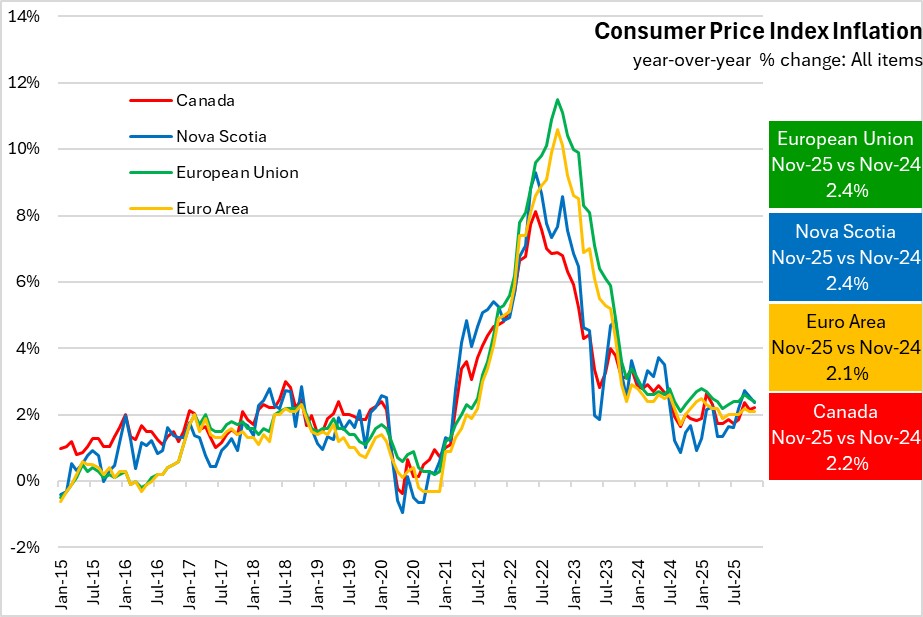
The fastest inflation was reported in Romania and Estonia, while the slowest inflation rate was in Cyprus and France.
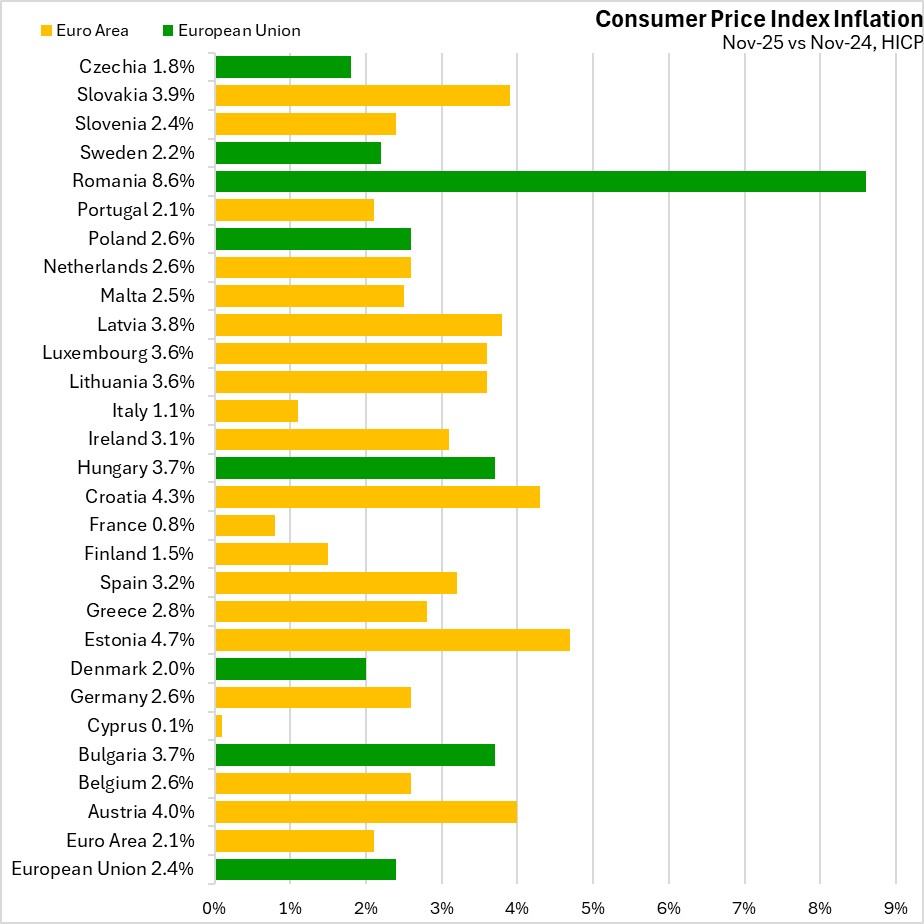
Energy price inflation was 0.3% in the European Union and -0.5% in the Euro Area in November 2025.
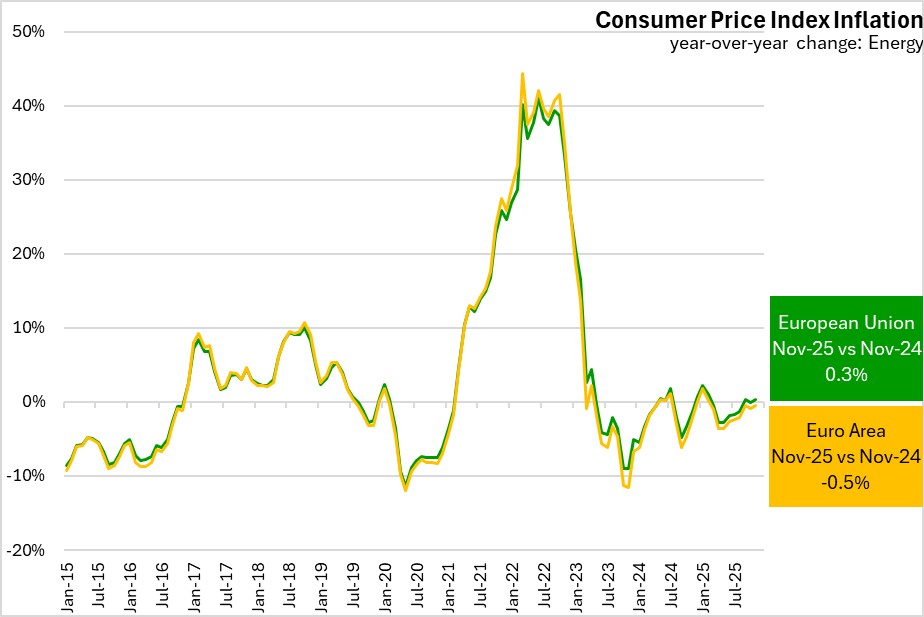
Food price inflation was 2.2% for the European Union and 1.8% in the Euro Area in November 2025.

Excluding the impacts of energy, food, alcohol and tobacco prices year-over-year inflation was 2.6% in the European Union and 2.4% in the Euro Area in November 2025.
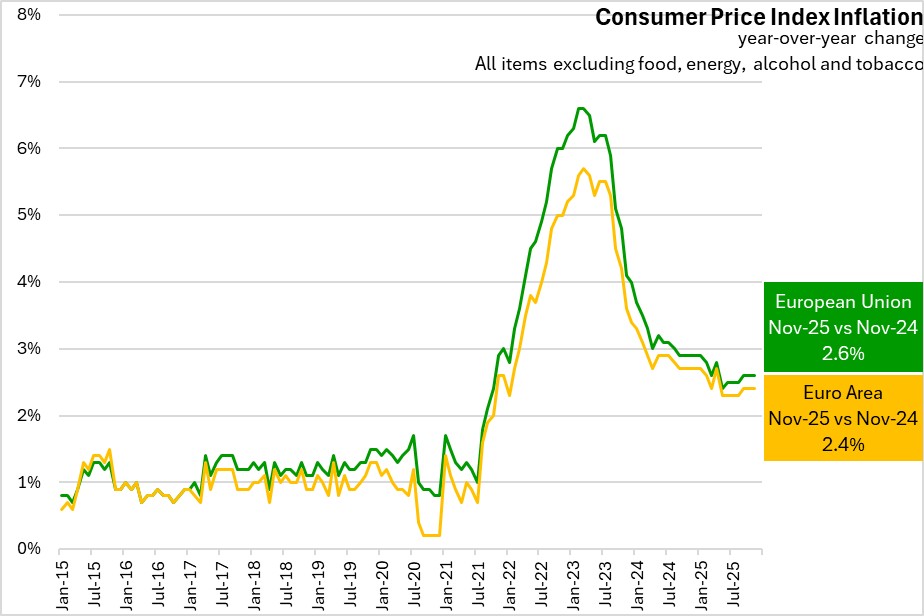
Source: Eurostat; Eurostat Data ANALYSIS OF CONSUMER PRICE INDEX FOR NOVEMBER 2025
Please note that the removal of the consumer carbon price on April 1, 2025 has affected energy prices, with all provinces (except Québec) also removing provincial consumer carbon prices. While other factors such as global commodity prices will continue to affect Canadian energy prices, it is expected that this policy change will be reflected in year-over-year rates until March 2026.
Nova Scotia’s all items Consumer Price Index (CPI) grew 2.4% year-over-year in November 2025, down 0.2 percentage points from the previous month.
Nationally, consumer prices grew 2.2% year-over-year in November 2025, the same pace as was reported in October. Inflation was highest in Manitoba and slowest in Prince Edward Island.

The most significant upward contributors (combining price increase as well as share of the consumption basket) to Nova Scotia's 2.4% year-over-year inflation were: rent, mortgage interest cost, homeowners' replacement cost, purchase and leasing of passenger vehicles, and financial services.
The largest downward year-over-year contributions were from: gasoline, inter-city transportation, furniture, women's clothing, and pet food and supplies.
On a monthly basis, Nova Scotia's all items CPI was up 0.2% from October 2025 to November 2025. National prices were up 0.1% on average. There were price increases reported in eight provinces (led by New Brunswick) and declines in two provinces (led by Québec).
Major upward contributors to Nova Scotia's monthly consumer prices were: gasoline, sugar and confectionery, rent, other food preparations, and fuel oil and other fuels. Major downward contributors were: travel tours, traveller accommodation, women's clothing, furniture, and processed meat.
Energy prices play a significant role in inflation rates. Nova Scotia's energy prices (and overall inflation) are more sensitive to fluctuations in the global price of crude oil. Nova Scotia's energy prices were down 3.1% from November 2024 to November 2025. Year-over-year energy prices were down 5.1% nationally with nine provinces reporting decreasing energy prices (fastest: Alberta). Québec reported year-over-year growth in energy prices.
On a monthly basis, Nova Scotia's energy prices were up 2.4% from October 2025 to November 2025. National energy prices were up 1.8% with eight provinces reporting higher prices compared to the previous month, led by Ontario. Saskatchewan and British Columbia reported declines compared to October 2025.
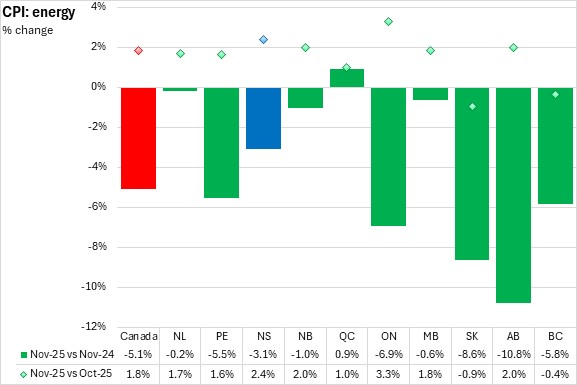
In November 2025, gasoline prices were down 8.4% compared to a year ago in Nova Scotia. All provinces except Manitoba reported lower gasoline prices, with Saskatchewan reporting the fastest decline. Québec reported slowest decline in gas prices year-over-year.
Gasoline prices were up 3.7% from October to November in Nova Scotia, the fastest increase among provinces. Nationally gasoline prices were up 1.8% with eight provinces reporting monthly growth. Saskatchewan and British Columbia reported declines month-over-month.

Nova Scotia's year-over-year fuel oil prices were up 1.1% in November 2025 compared with November 2024. Nationally, the fuel oil and other fuels price index increased 8.5% compared to November 2024, with eight provinces reporting increases. New Brunswick reported the largest increase in fuel oil prices while British Columbia reported the only decline.
On a monthly basis, Nova Scotia's fuel oil prices were up 2.7%. National fuel oil prices were up 5.2% from October to November, with increases observed in all of the nine reporting provinces. Saskatchewan reported the fastest monthly fuel oil price increase, while British Columbia reported the slowest.

Food prices increased 3.4% in Nova Scotia year-over-year, below national average food price inflation of 4.2% in November 2025. Food prices were up in every province, led by Saskatchewan.
On a monthly basis, Nova Scotia's food prices grew 0.7% from October to November. National food prices were up 1.3% with all provinces reporting growth. Québec reported the fastest monthly growth while the slowest was in Newfoundland and Labrador.

Food and energy prices are heavily influenced by volatile global commodity markets. Nova Scotia's underlying inflation rate excluding food and energy was 2.9% from November 2024 to November 2025. Nationally, inflation excluding food and energy was 2.4% with year-over-year increases in all provinces. Manitoba reported the fastest increases in inflation excluding food and energy prices while Prince Edward Island reported the slowest growth.
On a monthly basis, Nova Scotia's prices for all items excluding food and energy were down 0.2% from October to November. Nationally, prices for all items excluding food and energy were down 0.4%, with seven provinces reporting declines, led by Québec. Only New Brunswick reported growth, while Newfoundland and Labrador and Prince Edward Island reported no change compared to October.
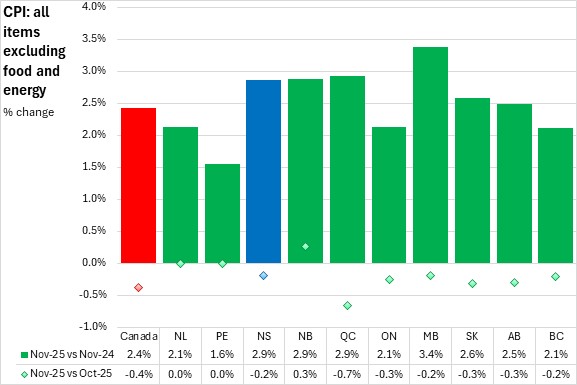
Year-over-year shelter cost inflation was 4.2% in Nova Scotia in November 2025. National shelter prices were up 2.3% with increases in all provinces. Québec had the largest increase in shelter prices, while Ontario reported the slowest increase.
Monthly shelter costs were up 0.6% in Nova Scotia from October to November. Nationally, shelter costs were up 0.1%, with increases in eight provinces. The largest monthly increase was in Prince Edward Island, with Saskatchewan reporting no change and Québec reporting the only monthly decline.
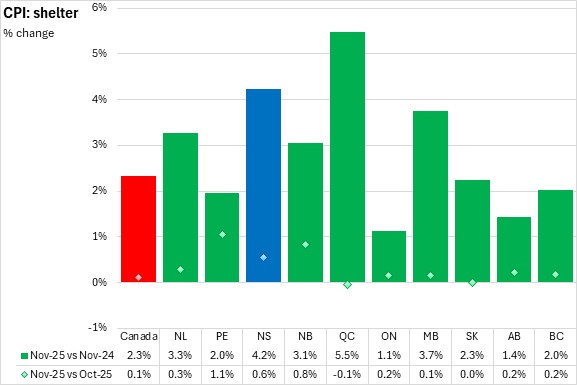
Among detailed food products with available data, Nova Scotia's year-over-year inflation was fastest for coffee/tea, beef, and sugar/confectionary. The largest year-over-year price declines were for fats/oils and cheese.

In detailed shelter cost components, all components except home maintenance/repairs had price increases year-over-year with the fastest growth for home/mortgage insurance and rent.
Household operations/furnishings costs were up 2.5% overall. The largest year-over-year price increase was for paper/plastic/aluminum products, while prices fell the most for furniture.
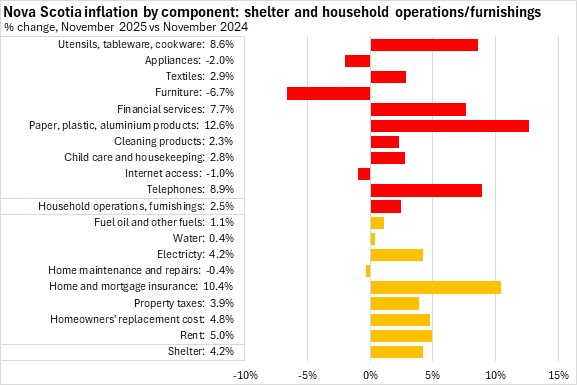
Clothing and footwear prices were up 0.4% year-over-year in November with the fastest price growth in clothing/accessories/jewellery. Woman's clothing prices declined the most in November.
Health and personal care costs were up 3.9% year-over-year on gains in all sub-components except non-prescribed medicine. Personal care services and supplies reported the largest price increases.
Overall transportation costs were down 0.8% year-over-year in November. The fastest increases were among taxis/other transportation, while there were notable declines for inter-city transportation and gasoline.
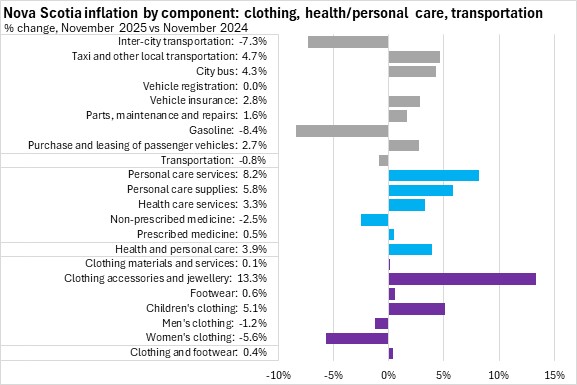
Nova Scotia's overall prices for recreation, education and reading were up 2.0% from November 2024 to November 2025 with the fastest increase for home entertainment equipment/services and travel services/accommodations, and declines reported for recreational equipment/services (excluding RV's) and purchase/operation of recreational vehicles.
Nova Scotia's prices for alcohol, tobacco and recreational cannabis were virtually unchanged year-over-year, with an increase in prices for beer and wine from stores and alcohol from licensed establishments offset by declines in all other categories, led by recreational cannabis.
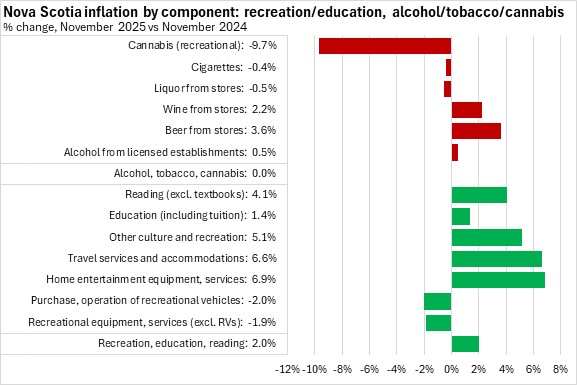
Trends
Since the start of the Bank of Canada's inflation-targeting monetary policy regime, inflation for all items has generally been in the 0-4% range. Periods of above target inflation are typically followed by periods of slow price growth or declines. The most recent acceleration in inflation was the strongest since the inflation-targeting era began, though this inflation has receded with tighter monetary policy and lower commodity prices.
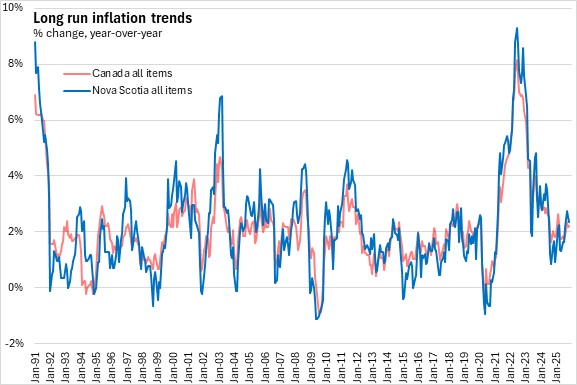
Many of these periods of accelerated and slowed inflation are attributable to volatile commodity prices, especially energy prices. Once the more volatile commodity prices are excluded, inflation in Nova Scotia has largely been below 2% for much of the last 20 years. However, the recent rise in inflation through 2021-2024 spread beyond commodity prices, resulting in the longest period under the Bank of Canada's inflation-targeting regime with Nova Scotia's CPI excluding food and energy above 3%.
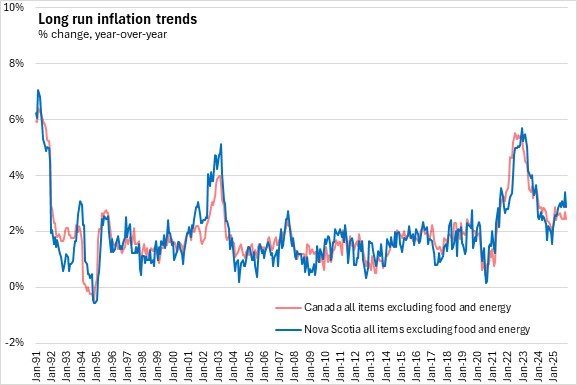
The Bank of Canada examines 'core' measures of inflation that are intended to remove the effects of volatile components and capture underlying inflation trends that are more connected to capacity in the Canadian economy. Core measures of inflation August also indicate where all items inflation is headed.
Canada's core measures of inflation remained mostly at or below the Bank's target of 2% for over a decade prior to 2021. However, core inflation measures rose in 2022, peaking at over 6% for the CPI-common measure before declining around the beginning of 2023. Core measures of inflation have been rising since the end of 2024.
The Bank of Canada's year-over-year core inflation measures in November 2025 were:
- CPI-common: 2.8% (up from 2.7% in the previous month)
- CPI-median: 2.8% (down from 3.0% the previous month)
- CPI-trim: 2.8% (down from 3.0% the previous month)
The core CPI excluding volatile products and the effects of indirect taxes was up 2.9% (unchanged from the previous month).
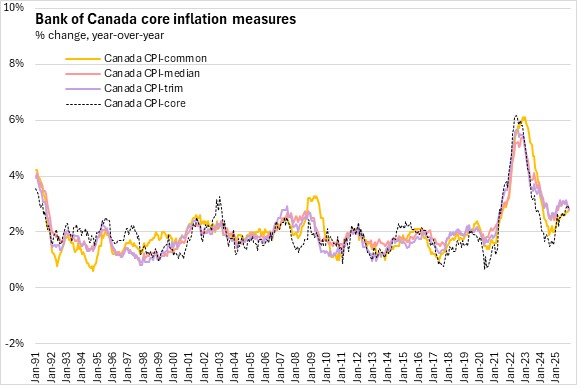
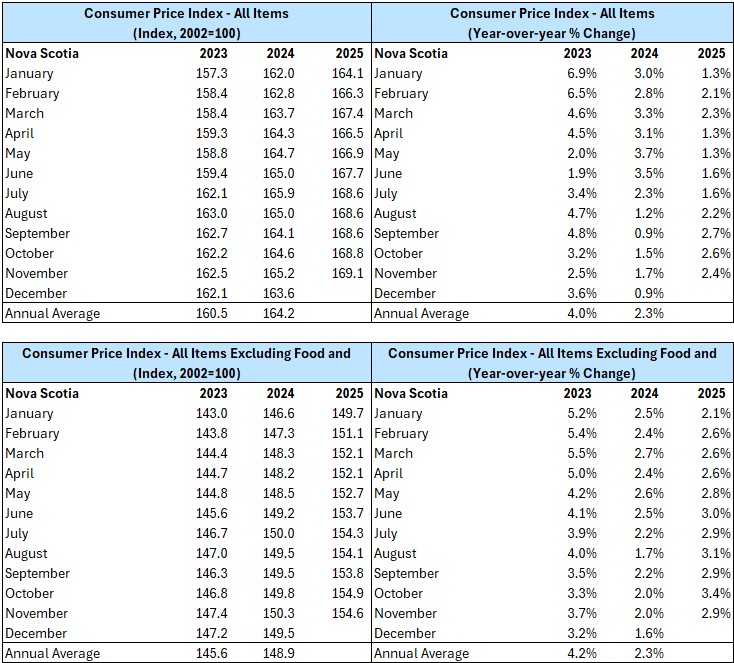
Source: Statistics Canada. Table 18-10-0004-01 Consumer Price Index, monthly, not seasonally adjusted; Table 18-10-0256-01 Consumer Price Index (CPI) statistics, measures of core inflation and other related statistics - Bank of Canada definitions CONSUMER PRICE INDEX, NOVEMBER 2025
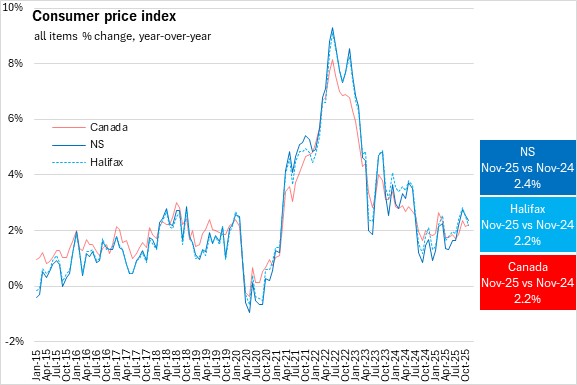
Year-over-year (November 2025 vs November 2024)
All items: Consumer prices in Nova Scotia increased 2.4%, down 0.2 percentage points from inflation in the previous month. The national average inflation was 2.2%. In Halifax consumer prices increased 2.2%.
All items excluding food and energy: Nova Scotia consumer prices outside of food and energy increased 2.9%. This was above the national average increase of 2.4%.
Month-over-month (November 2025 vs October 2025)
All items: Consumer prices in Nova Scotia were up 0.2% in November 2025 compared with October 2025. Nationally, consumer prices were up 0.1% compared to the previous month. In Halifax consumer prices were up 0.2%.
All items excluding food and energy: Nova Scotia consumer prices excluding food and energy were down 0.2% month over month in November 2025. Nationally, consumer prices outside of food and energy decreased 0.4% from the previous month.
Source: Statistics Canada. Table 18-10-0004-01 Consumer Price Index, monthly, not seasonally adjusted AVERAGE RETAIL PRICES, OCTOBER 2025
Year-over-year (October 2025 vs October 2024)
Over the last year (October 2025 vs October 2024), the consumer price index for all items in Nova Scotia excluding food increased by 2.5%. Food prices as a whole rose 2.7%. At the same time average weekly earnings across all Nova Scotia industries increased by 5.4%.
In the last year, the following products reported lower prices in Nova Scotia: beef rib cuts, chicken (thigh, drumsticks), soy milk, butter, bananas, limes, cucumber, mushrooms, salad greens, frozen french fries, frozen mixed vegetables, frozen pizza, crackers, pasta, white rice, cereal, white sugar, olive oil, baby food, peanut butter, mayonnaise, canned beans/lentils, canned corn, salsa, pasta sauce, laundry detergent.
The following products reported price growth that exceeded the gains in average weekly earnings: beef (striploin, ground), pork (loin, rib, shoulder), chicken (whole, breasts), bacon, wieners, salmon, shrimp, canned salmon, meatless burgers, pears, strawberries, cabbage, celery, lettuce (iceberg, romaine), peppers, squash, frozen broccoli, frozen spinach, frozen strawberries, cookies, wheat flour, apple juice, orange juice, coffee, tea, vegetable oil, canola oil, infant formula, canned soup, tofu, salad dressing, almonds, peanuts, deodorant, toothpaste.
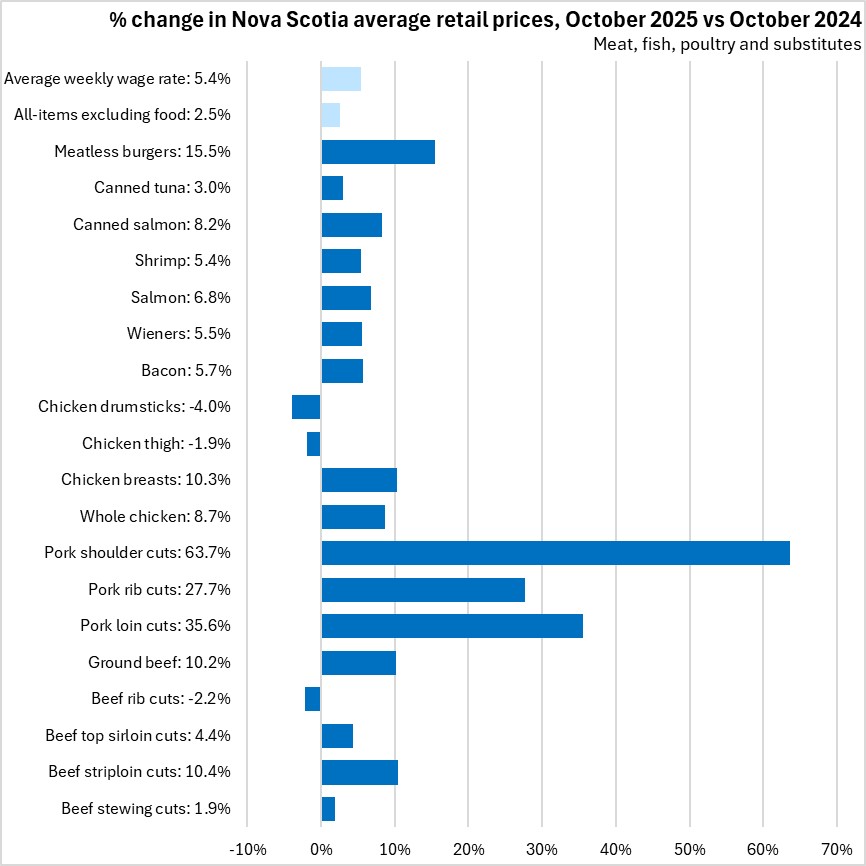
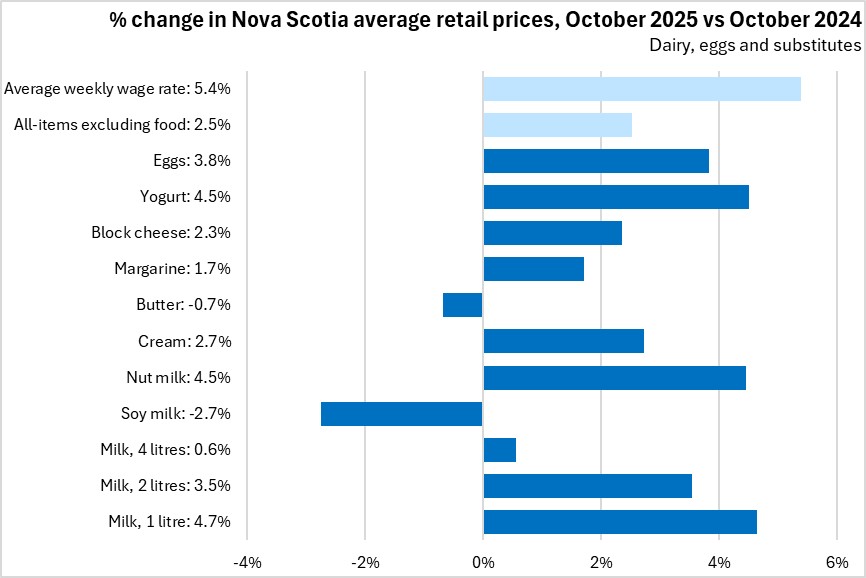
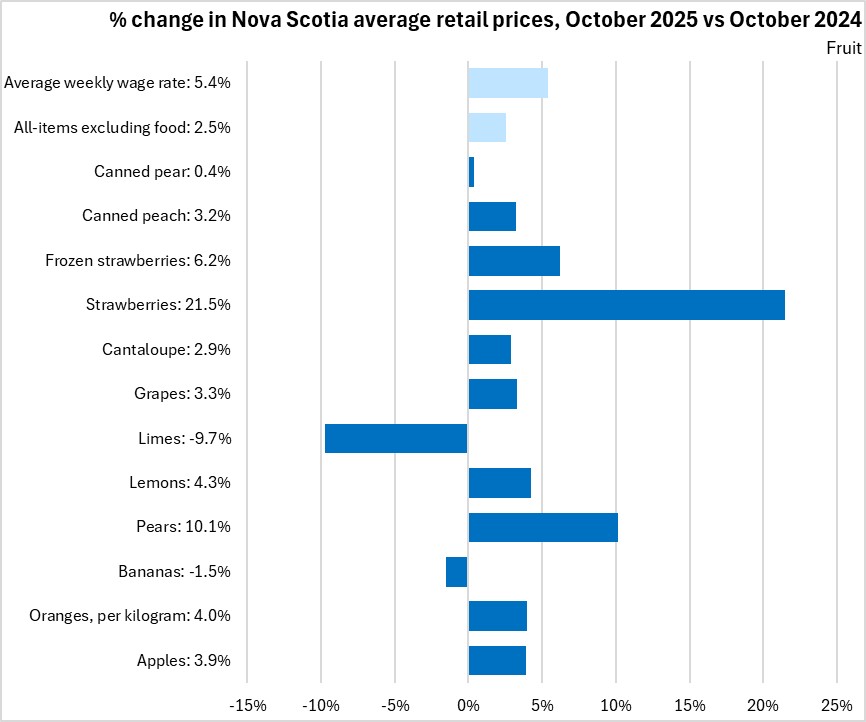
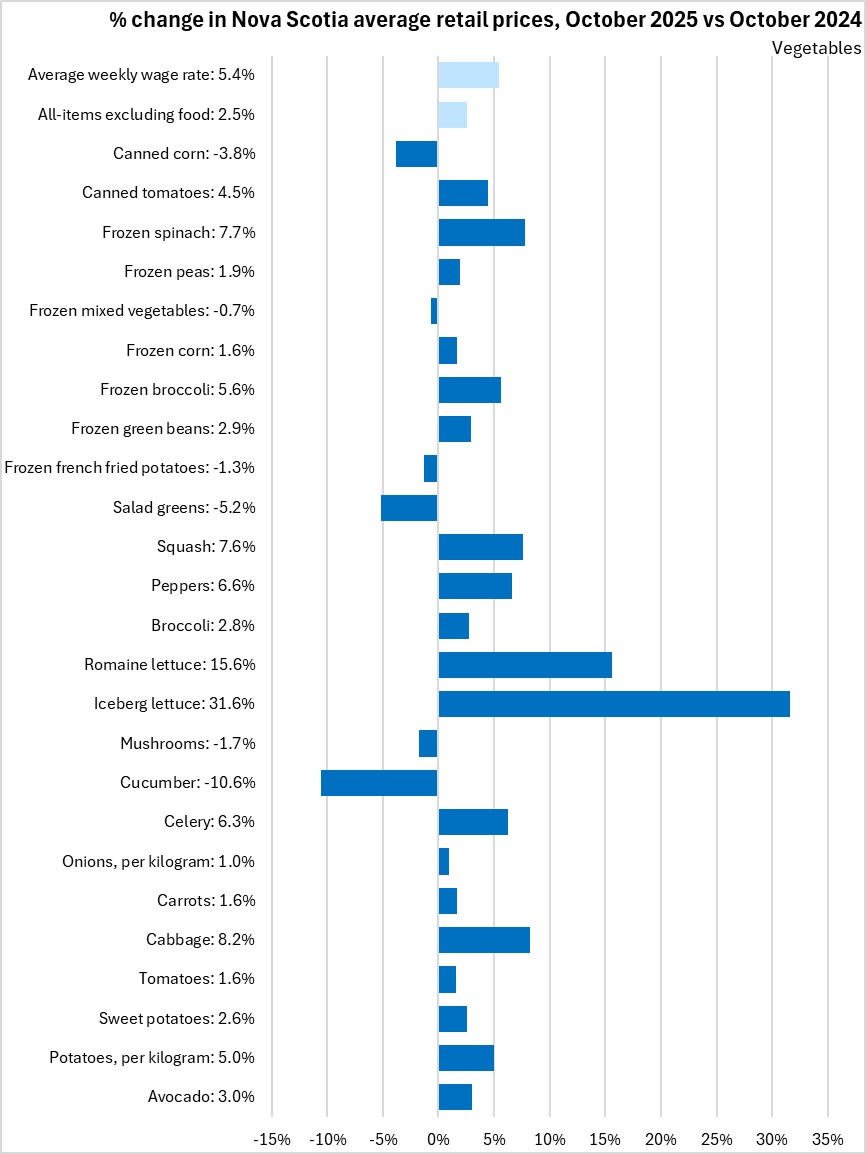
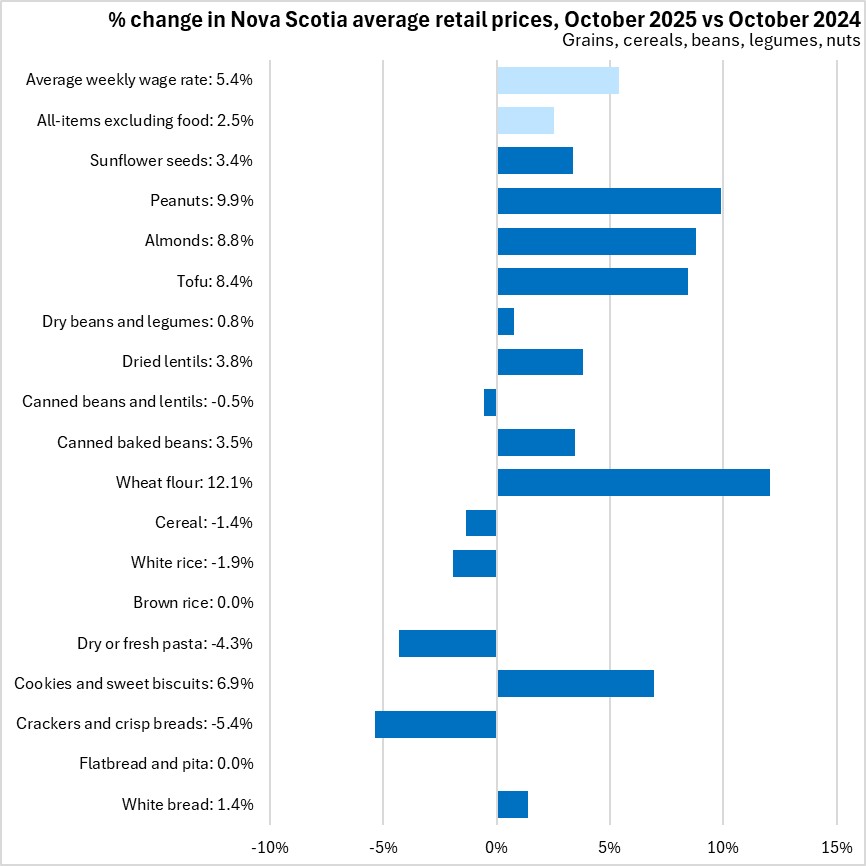
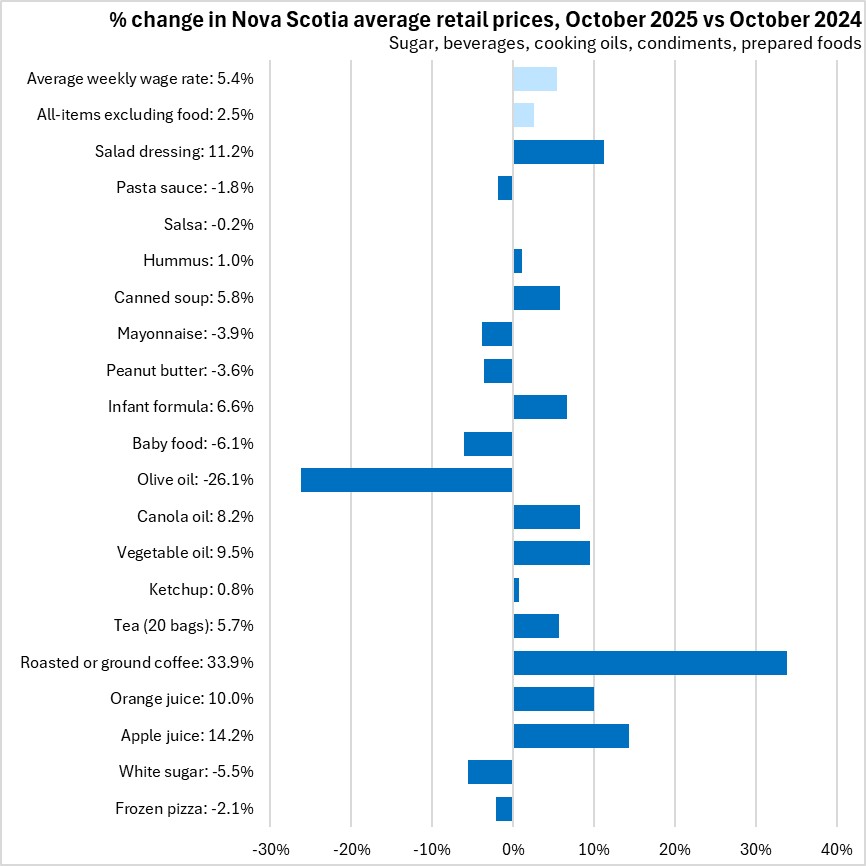
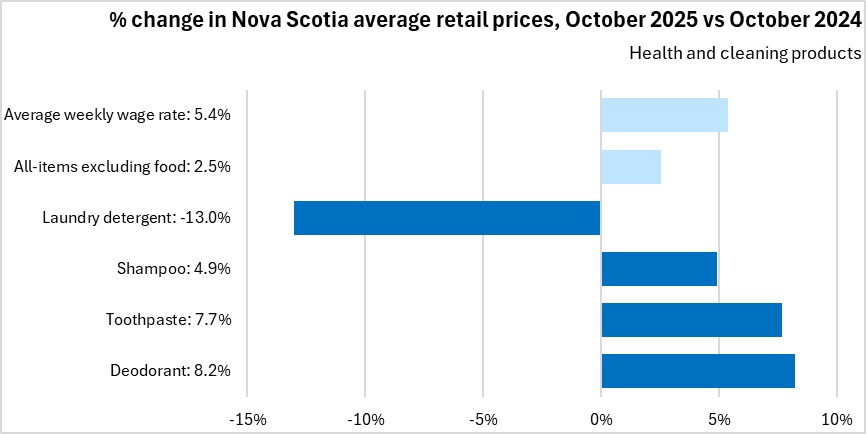
Nova Scotia prices relative to national average (October 2025)
Nova Scotia food prices were below national averages for the following products: beef (top sirloin, rib, ground), chicken thigh, bacon, shrimp, canned salmon, milk (2l), lemons, salad greens, white sugar, apple juice, baby food, infant formula, mayonnaise, pasta sauce, shampoo, laundry detergent.
Nova Scotia food prices were more than 10% higher than the national averages for the following products: pork (loin, rib, shoulder), chicken (breasts, drumsticks), canned tuna, cream, eggs, apples, oranges, bananas, pears, limes, grapes, cantaloupe, avocado, potatoes, tomatoes, onions, celery, cucumber, mushrooms, iceberg lettuce, broccoli, peppers, squash, flatbread, white rice, tea, vegetable oil, canola oil, olive oil, canned baked beans, canned beans/lentils, dried lentils
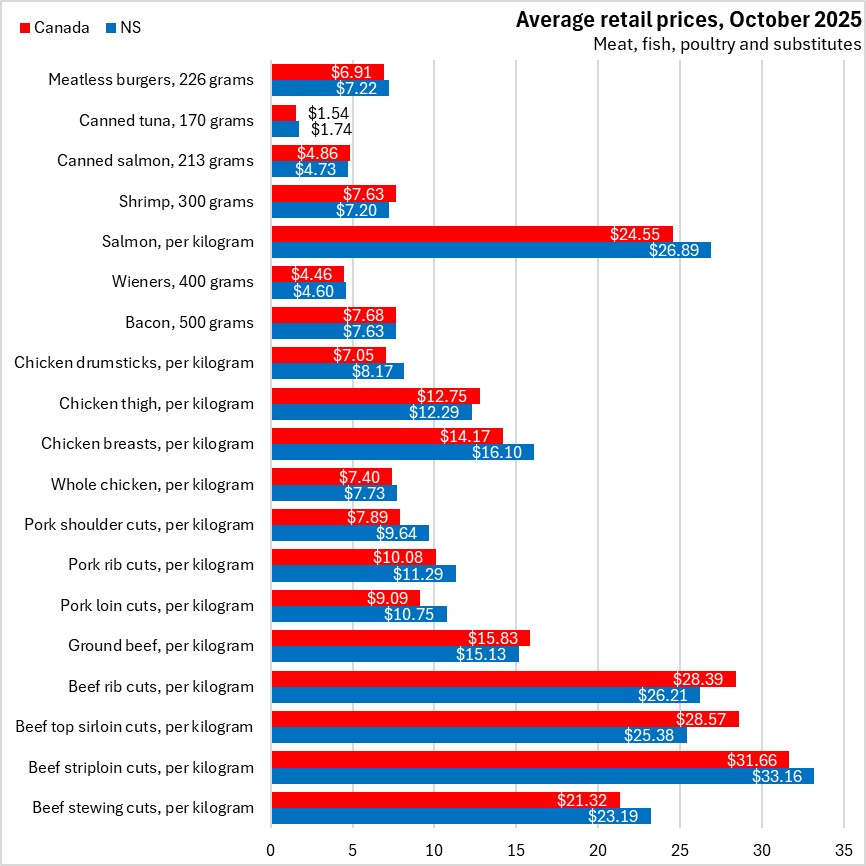
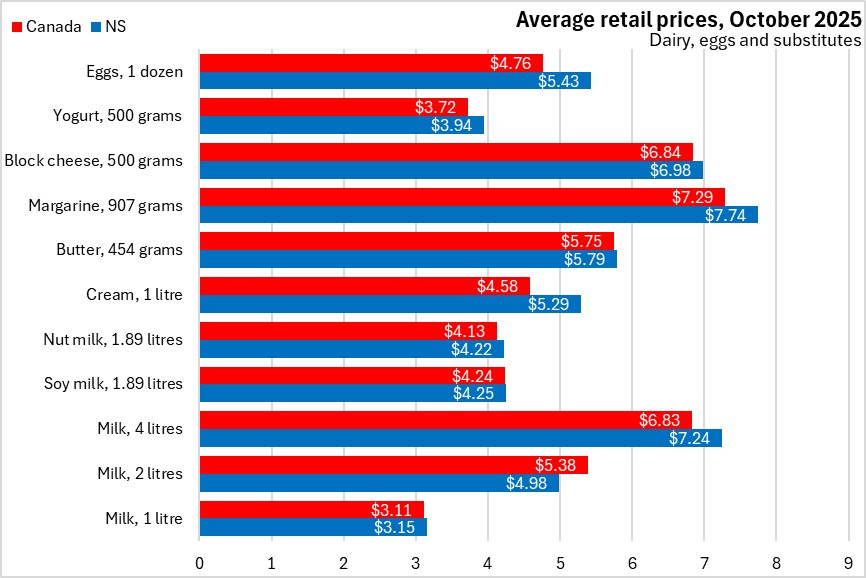
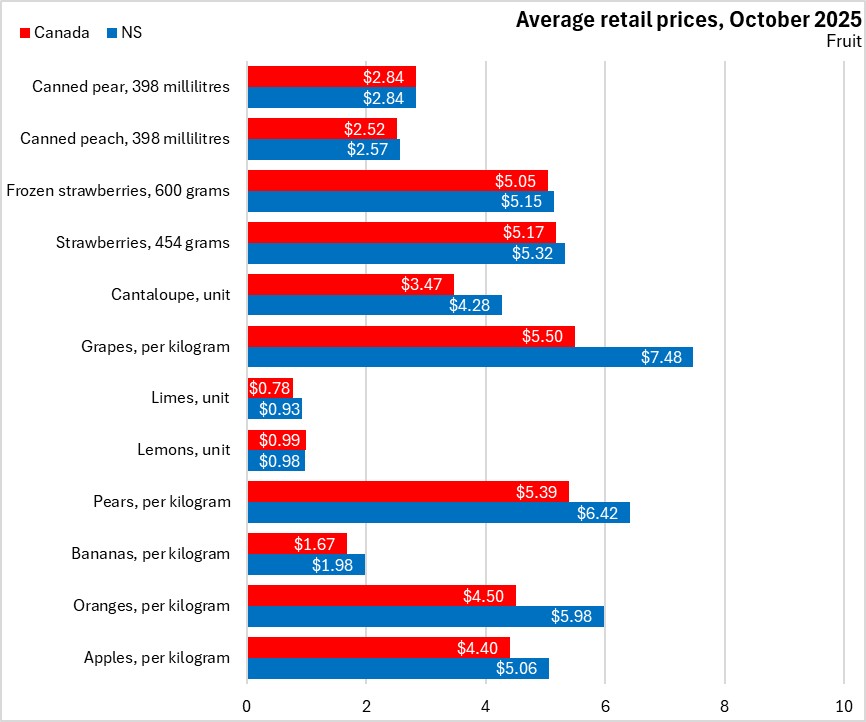
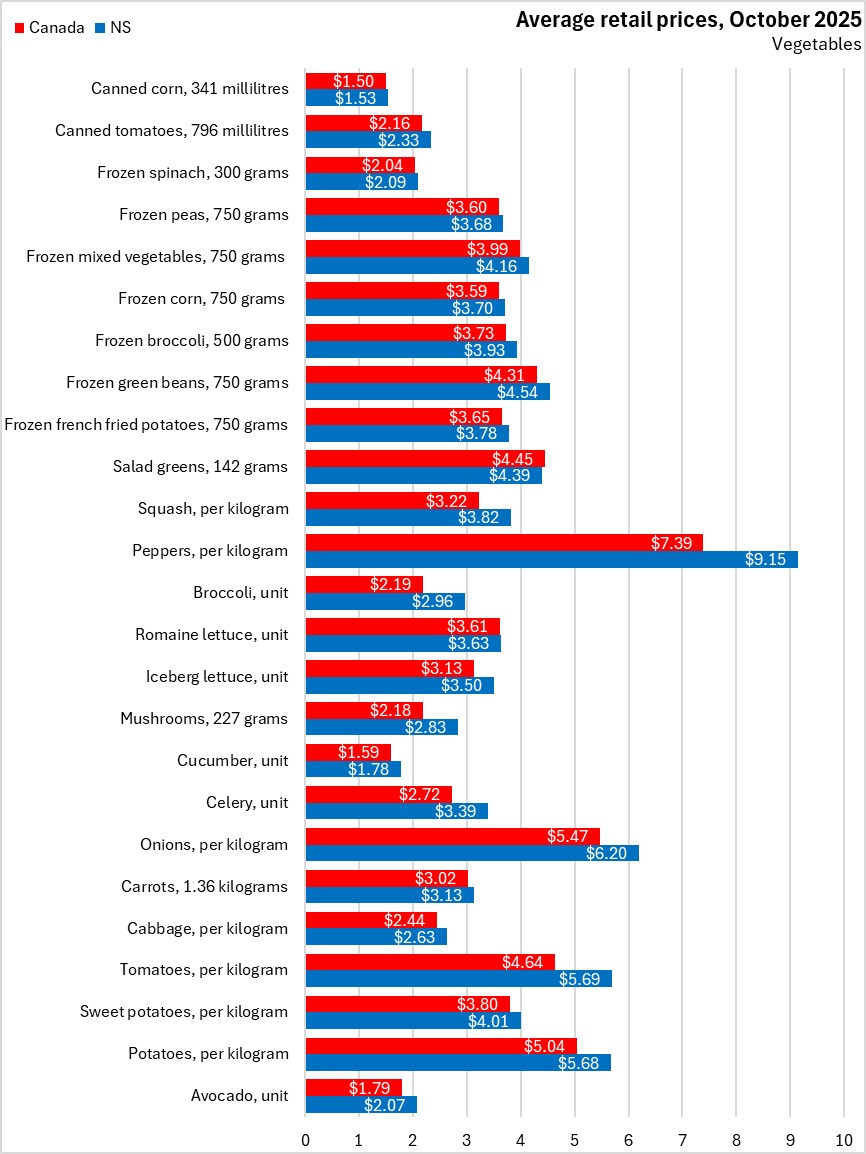
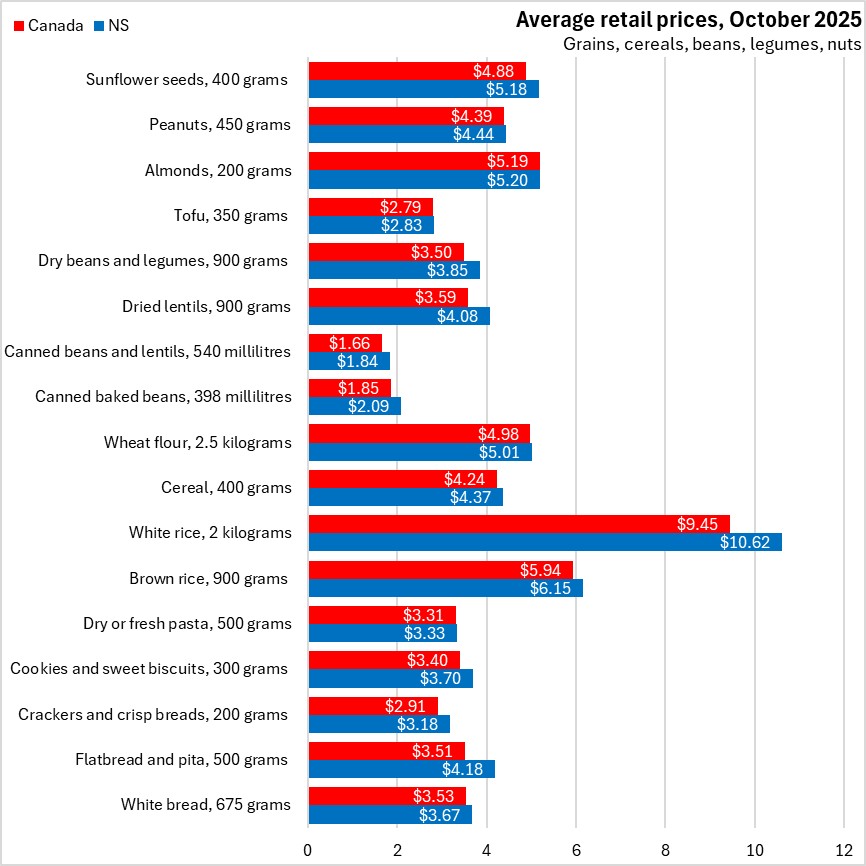
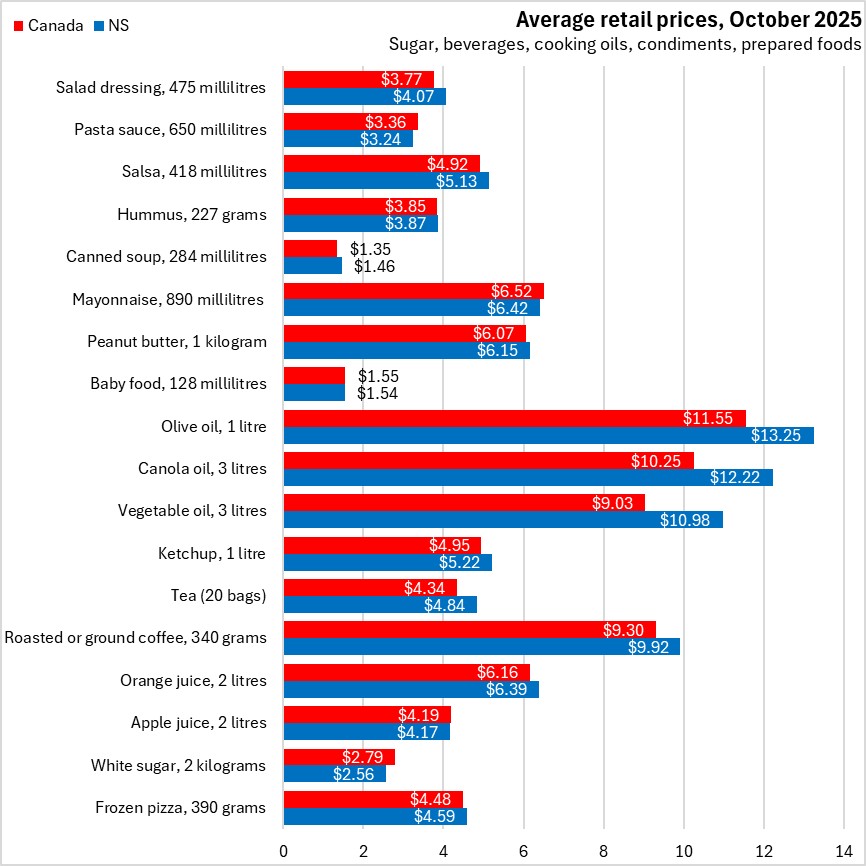


Notes: Statistics Canada makes available scanner data on prices collected for a range of food and personal care items. These prices are collected through point-of-sale (transaction) data obtained directly from Canadian retailers. The data represent commonly purchased items (which do change over time), but are not representative of the Consumer Price Index weights. Over time, products are rotated and quantity or quality October change. Comparisons of prices from one time period to another reflect quantity and quality changes as well as price changes.
For the purposes of this analysis, the 110 items reported by Statistics Canada will be grouped into:
- Meat, fish, poultry and meat substitutes
- Dairy, eggs and substitute products
- Fruit (including canned and frozen products)
- Vegetables (including canned and frozen products)
- Grains, cereals, beans, legumes and nuts
- Sugar, juices, cooking oils, condiments and prepared foods
- Health and cleaning products
Source: Statistics Canada. Table 18-10-0245-01 Monthly average retail prices for selected products; Table 18-10-0004-01 Consumer Price Index, monthly, not seasonally adjusted; Table 14-10-0063-01 Employee wages by industry, monthly, unadjusted for seasonality
|